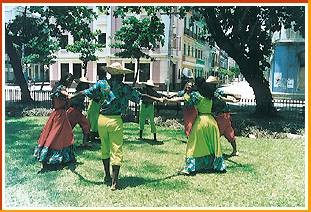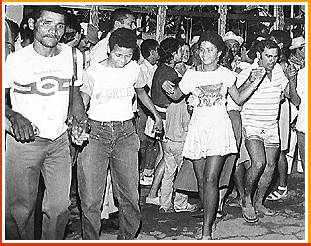"Na areia onde o mar chegou, "On the edge of the sand where the sea breaks a ciranda acabou de começar, e ela é! the ciranda has just begun! E é Praieira!" It's the dance of the Beach!" In etymological terms, the word "ciranda" has been the subject of many differing interpretations. For the Catholic priest, Jaime Diniz, a pioneer in the study of ciranda, the word originates from the Spanish word Zaranda, which is a utensil for sifting flour, which in turn, had evolved from an Arabic word - Ηarand. This theory is also confirmed by Caldas Aulete, in his Contemporary Dictionary of the Portuguese Language. It is very common to find ciranda defined in Brazilian literature as a children's circle game. In fact, in other regions of Brazil, ciranda is exclusively a children's pastime. However, in the state of Pernambuco, it is principally danced by adults, although of course, children are never excluded should they desire to enter the 'ring'. As with the coco, the ciranda is an extremely community spirited dance and shows no prejudice towards sex, color, age, or social or economic status.
The name given to the participant of the ciranda is cirandeiro - which, broadly translated, would be - cirandarer. Besides the 'cirandarers' or dancers, there is the traditional master, the foreman and the musicians, who all stay in the center of the ring. It is the responsibility of the master to begin the dance, and to give commands during its execution. He is also responsible for the songs and for playing in the ganzá (a kind of maraca), and also to maintain order when necessary. He also makes use of a whistle, which hangs around his neck. He is the most important participant of the dance and very often his (or her) name serves to identify the particular ciranda group, e.g. Barcho's Ciranda, Lia's Ciranda. The researcher, Evandro Rabello, reveals that some of these masters are often armed with a stout stick, made of strong wood and often decorated with rings. This stick is kept beneath his arm or, or suggestively, between his legs. This utensil is commonly called a walking stick, and according to the author, it serves as a weapon of defense in extreme cases. In the case where a particular ciranda group has a Mistresses, then the stick is dispensed with. This fact is often the subject of much joking, and there are those who say that the stick is the "Master's document"- a direct reference to his masculinity. The foreman may play either the bombo or the caixa (two different kinds of drum). When the master or mistress is absent, then it is the foreman who stands in. The maracas or the two drums, mentioned above, are the basic instruments of the traditional ciranda. Sometimes, it is possible to find a cuica (a kind of squeaky drum), o pandeiro (a kind of small tambourine/ drum), an accordion, or some kind of wind instrument. The songs that the master sings can either be already established songs (of his own composition or that of other masters), improvisations or even popular, well known commercial songs transformed into the rhythm of ciranda. The steps of the dance vary according to the spirit of the particular dance in action, which is not necessarily definitive. There are three main steps which feature: a onda - the wave, o sacudidinho - the little shake and o machucadinho - the little crushing step. . There is no traditional costume for this particular dance and the dancers are free to use any kind of clothing they wish. It is also possible to find this dance taking place at any time of the year, since there are no determined dates. There are however, some religious feast days on which the dance is not performed, such as, Ash Wednesday and All Saints' Day, etc. During the 70's, many cirandas began to be performed in and around the tourist areas of Recife, such as St Peter's Square and Casa da Cultura (an old prison converted into a massive handicraft market). This has modified, in some ways, the character of the dance and it has now become a kind of spectators show. Consequently, some transformations were inevitable. The musicians, the master and the foreman, for example, no longer stay in the center of the ring. They now stand outside the circle, very often using a microphone and loudspeakers. Also, under such 'show like' circumstances, there is often a time limit for the dance. Many contemporary composers from Pernambuco are using ciranda rhythms in their music. Chico Science (see opening page of site), and Lenine are two fine examples of musicians who enrich their music with this tremendously involving rhythm. |

